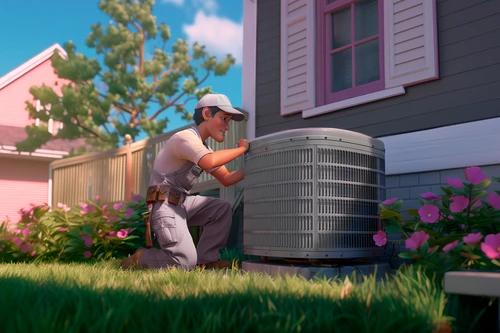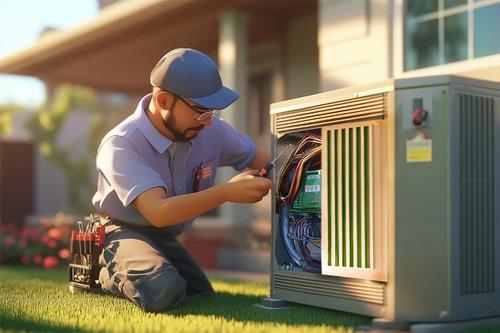How to Navigate the HVAC Industry’s Switch to R-454B Refrigerant

New Environmentally Friendly Refrigerants Paving the Way for Sustainability
If you own an air conditioner or heat pump, you’ve likely heard the term “refrigerant,” but may not fully understand what it is or how it impacts your purchasing decision. Don’t worry – you’re not alone. While the concept of refrigerant can be confusing for homeowners, it’s helpful to have some basic knowledge of it so you’re better prepared for repairing or replacing your HVAC system, especially as the industry transitions to more environmentally friendly options.
The HVAC industry is shifting away from older refrigerants like R-410A to more sustainable choices such as R-454B in 2025 to reduce Global Warming Potential (GWP). While this is great news for the environment, this change may lead to higher costs for some new HVAC systems and questions from homeowners like you.
HVAC.com can help you navigate the changing refrigerant landscape. Our advisors are ready to answer your questions about why the shift is happening, the benefits it brings, your options, and how it might affect costs. We’re also here to assist with any other HVAC concerns, including whether to repair or replace your current system.
Understanding the Role of Refrigerants in HVAC Systems
Central air conditioners, heat pumps, and ductless mini-splits all require refrigerants to operate. Refrigerant is the lifeblood of these systems, facilitating the heat transfer process that is crucial for cooling or heating indoor spaces and maintaining comfort.
In cooling mode, the refrigerant absorbs heat indoors, turning from a liquid into a low-pressure gas through evaporation; this absorbed heat is then released outside as the refrigerant condenses back into a liquid within the condenser coil, allowing the cycle to repeat. During a heating cycle, heat pumps use a reversing valve to switch between cooling and heating modes. During the winter months, a heat pump uses refrigerant to extract heat from the outdoor air to warm indoor spaces.
Older refrigerants, like R-22 (Freon) and R-410A, have a high GWP and are being phased out due to their negative impact on the environment. These refrigerants contain potent greenhouse gases, such as hydrofluorocarbons (HFCs) and hydrochlorofluorocarbons (HCFCs), which contribute to climate change. To limit these effects, more eco-friendly alternatives such as R-454B are being adopted in newer systems.
R-454B: A Promising New Refrigerant
While many of the leading HVAC manufacturers began phasing out R-410A in 2024, all companies are required to manufacture new air conditioning and heat pump systems using R-454B starting on Jan. 1, 2025 to meet industry standards. R-454B is more sustainable with a lower GWP and zero ozone depletion potential (ODP). R-454B is a mix of R-32 and R-1234yf which are more environmentally friendly.
The greener alternative to R-410A features 78% less GWP, which is below the Environmental Protection Agency’s 700 GWP limit for new residential and light commercial air conditioning and heat pump systems, according to the EPA.
Manufacturers also tested R-454B refrigerants in the U.S. Department of Energy’s Cold Climate Heat Pump Challenge, where it showcased exceptional performance and surpassed efficiency requirements.
The Benefits of Switching to R-454B Refrigerant
The main reasons the HVAC industry is switching from R-410A to R-454B include:
- Lower GWP: With a significantly lower GWP, R-454B will reduce the environmental impact of HVAC systems by emitting fewer greenhouse gases, contributing to a slower rate of climate change. These eco-friendly alternatives offer improved cooling and heating efficiency while supporting sustainability efforts.
- Higher Efficiency. R-454B can be up to 5% more efficient than its predecessor, R-410A, in many applications, which lowers energy consumption and home utility costs.
- Regulatory Compliance: R-454B helps future-proof systems as refrigerant regulations tighten globally. New residential and commercial ducted HVAC systems are required to use advanced refrigerants starting in January 2025. HVAC equipment manufactured before 2025 has a one-year grace period and must be installed before Jan. 1, 2026.
- Enhanced Performance: R-454B maintains better performance across a wide range of temperatures, including extreme highs and lows. Many top HVAC manufacturers are developing heat pump systems that can work efficiently in temperatures below zero.
- Compatibility with Existing Systems: R-454B can often replace R-410A without major infrastructure changes, easing retrofits and upgrades.
Will Systems that Use R-454B Cost More?
You may notice higher upfront costs for new HVAC systems in 2025 because of the implementation of R-454B refrigerant.
In addition to the potentially higher cost of the new refrigerant, air conditioners and heat pumps will require updated manufacturing processes and technology to work with more environmentally friendly options, which may raise prices. HVAC technicians will also need specialized training to handle these new refrigerants, potentially increasing both training hours and labor costs. Additionally, installing and maintaining systems that use R-454B may be more expensive due to the need for specialized tools and equipment.
However, while the initial cost may be higher, R-454B offers long-term benefits, including improved energy efficiency and a reduced environmental impact, which can justify the higher price over time.
Systems that use R-410A that were manufactured prior to 2025 can still be installed before 2026, according to the EPA. However, their availability depends on the brand and the region you live in. Ask your local dealer to understand your options.
Should I Choose HVAC Repair or Replacement?
If your current AC unit or heat pump uses R-22 or R-410A, you can continue to maintain and repair the system, but you should evaluate the pros and cons of repair vs replacement.
HVAC Repair
If your unit is under 10 years old and still covered under warranty, it’s typically recommended to repair the system. In these cases, your system uses R-410A (2010 or newer) which will be plentiful and affordable for years to come.
If the system is over 10 years old and the cost to repair/recharge the refrigerant system with R-410A is less than $3,000, a repair might still be your best option, especially for one-time fixes.
HVAC Replacement
If your AC or heat pump uses R-22 (2010 or older), you should consider replacement if it requires a refrigerant recharge or line repair. Due to its limited availability, R-22 can cost more than $500 to recharge, and some HVAC technicians don’t have it in stock anymore. R-22’s production was banned in 2020, and only recovered or recycled supplies are now available.
Instead, consider opting for a new air conditioner or heat pump featuring R-454B or R-410A.
However, if the environment is a primary concern when buying a new HVAC system, you may want to consider replacing a unit that uses R-410A if it requires a repair. While it lacks ODP, it has a higher GWP than R-22 and poses environmental risks if it leaks due to operating at high pressures. For this reason, R-410A is also being phased out, which started with a 90% production allowance in 2022 that drops to 15% in 2036.
The Future of New HVAC Refrigerants Is Here
The evolution of new refrigerants reflects a concerted effort by HVAC industry leaders to lower environmental impact and foster sustainability. Hopefully this guide provided clear insights into the HVAC refrigerants landscape and how it can affect your decision to repair or replace your system.
If you have questions about the transition to R-454B or any other HVAC-related concerns, contact HVAC.com to chat with an advisor.


